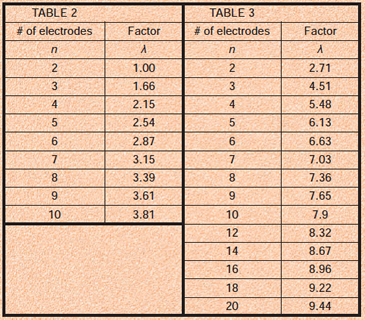BASIC EARTHING - Electrode Resistance |
||||||||||
RESISTANCE AREA OF AN EARTH ELECTRODE
|
||||||||||
SINGLE EARTHROD ELECTRODE - ELECTRODE RESISTANCE
The resistance of a single earth rod is calculated if the soil resistivity is known. An electrode driven vertically, the electrode resistance can be calculated using the equation:
MULTIPLE EARTHROD ELECTRODE-ELECTRODE RESISTANCE
|
||||||||||
The above equations assume that the rod electrodes can be
represented approximately by hemispherical electrodes, having the
same earth resistance. This assumption is satisfactory provided that the
spacing between the rods is less than their length. For electrodes equally spaced around a hollow square, e.g. around the perimeter of a building, use λ fromTable 3. For three rods placed in an equilateral triangle, or in a Lformation, use λ = 1.66. Table 3 may also be used for electrodes arranged in a rectangle, where n is given by (total number of electrodes/4)+1. Provided that the length to width ratio of the rectangle does not exceed 2, the error will be less than - 6%. |
 |
|||||||||
EARTH ROD ELECTRODE RESISTANCE USING E-MIX CONDUCTIVE EARTHING COMPOUND E-Mix conductive earthing compound, is a technique where the ground immediately surrounding an earth electrode is replaced with a low SINGLE EARTHROD ELECTRODE-ELECTRODE RESISTANCE
RESISTIVITY OF SOILS
REFERENCES |
||||||||||
|
||||||||||
|
|||||